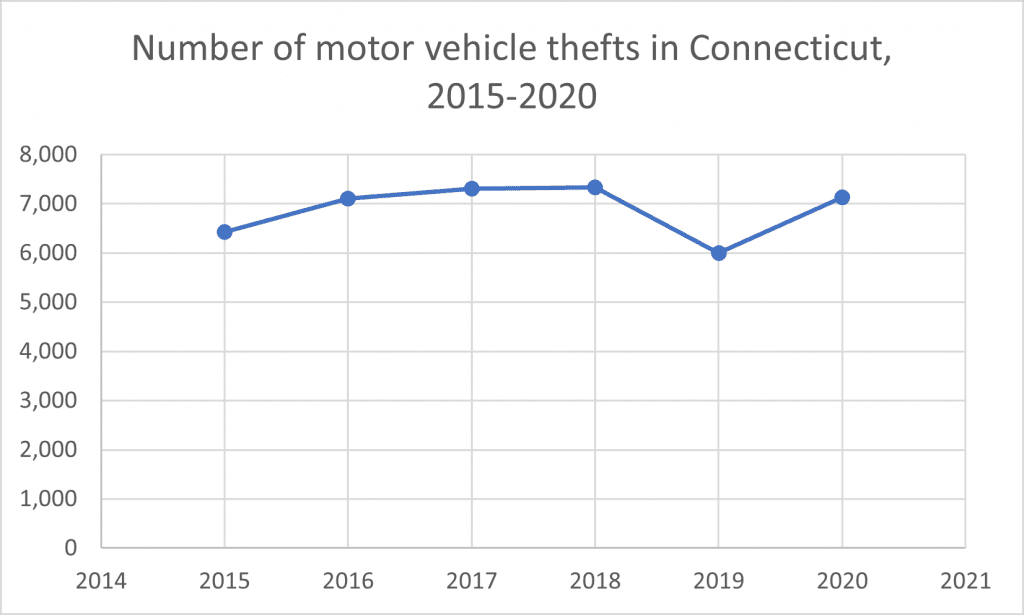A rise in car thefts in Connecticut suburbs has police chiefs and some legislators calling for greater punishments for the offending youths, even as others say that harsher penalties alone won’t fix the problem.
Mike Finkelstein, the police chief in East Lyme, said he’s seen an increase in motor vehicle thefts in the town over the last few years.
Finkelstein said that the majority of the break-ins he’d seen in East Lyme involved cars that were left unlocked. Thieves would enter the cars and steal credit cards left inside the vehicles, or simply get in the driver’s seat and take off.
“It’s a crime of opportunity,” said Finkelstein.
It’s a pattern that has repeated across the state, according to Ken Barone, project manager with the Institute for Municipal and Regional Policy at Central Connecticut State University.
He said the car thefts started to increase around the same time that the pandemic hit. He chalked it up to people having more time on their hands, and to the fact that, since no one was traveling, cars were just sitting in the driveway.
Connecticut’s data mirrors rates nationwide. According to data from the National Insurance Crime Bureau, motor vehicle thefts increased 9.2 percent in the first six months of 2020, compared with the same period in 2019.
However, Barone said that the number of car thefts in Connecticut in 2020 isn’t abnormally high — in fact, he said, the data shows that there were more car thefts in the state in 2016 and 2017 than there were in 2020.

According to the Connecticut Uniform Crime Reporting System, 7,134 cars were stolen in 2020, an increase of 19 percent over 2019, which was a record low for the state at 5,994 thefts. In comparison, 7,310 cars were stolen in 2017 and 7,333 in 2018.
Motor vehicle thefts, said Barone, have been trending downward since the 1990s, but started climbing again in 2013, around the time that car manufacturers began making vehicles that use key fobs. Barone said this could have contributed to the increase, since key fobs make it easier for people to forget their keys in the car.
Not victimless
In Connecticut, people under the age of 24 have consistently accounted for between 59 and 64 percent of motor vehicle crimes, although the percentage of those thefts committed by minors has decreased from 34 percent to 28 percent in the last decade, according to data from the Connecticut Department of Emergency Services and Public Protection.
Legislators are now considering a bill that would require juveniles who have repeatedly attempted to steal or stolen cars to wear GPS monitors around their ankles. It would also allow the Department of Children and Families to conduct an investigation into the family of a child who is repeatedly caught stealing cars.
The Council of Small Towns testified in support of the bill. Betsy Gara, the council’s executive director, said that about a dozen towns had approached her about the issue.
State Rep. Rosa Rebimbas, R-Naugatuck, a supporter of the bill, emphasized the fact that it focused on repeat offenders, and said that it would “empower” victims of the crimes.
“It’s not victimless, and people do feel violated,” said Rebimbas.
State Rep. Robyn Porter, D-New Haven, pointed out that while the suburbs were only just beginning to see more car thefts, urban centers had dealt with this problem for years.
Barone’s data supports this. He said that 15 years ago, car thefts were isolated to the big cities – mainly Bridgeport, Hartford and New Haven. Over the last decade, he said, the thefts have spilled over into the suburbs of central Connecticut.
“It doesn’t become a problem … until it does trickle into our neighbors’ suburban communities,” said Porter, who said that she was concerned that the bill would disproportionately affect black youth.
The bill also makes it a felony if an adult “knowingly causes, encourages, solicits, recruits, intimidates or coerces” a minor to steal a car.

State Rep. Craig Fishbein, R-Wallingford, referenced the book Oliver Twist, in which a character named Fagan uses kids to pick pockets and then sells the stolen items. Fishbein said this is what he imagines when he thinks of adults using children to steal cars, under the pretext that the child, as a juvenile, won’t receive the same punishment that an adult would.
However, Barone said there is no evidence that this is the scenario taking place.
Porter and State Sen. Gary Winfield, D-New Haven, argued that the age at which someone is classified as an adult in the bill should be 21 rather than 18, saying that a person’s brain is not fully developed until the age of 25, which affects their decision making.
Rebimbas disagreed.
“What we’re trying to do is get them while they are young,” said Rebimbas. “We want to give them the resources, the opportunity and the help while it still makes a difference in their lives early on — as early as possible.”
Whodunit?
Barone pointed out that the penalties don’t address another central problem of motor vehicle thefts — finding the perpetrators. According to Barone, the vast majority of car thefts – about 89 percent statewide – are never solved.
“Even if you were to enhance penalties on juveniles for committing these offences, you are arresting so few juveniles … that you likely will not have an impact on the overall trend in the crime,” said Barone.
Finkelstein said the legislature needs to consider other policies that would make it easier for police to catch the offenders — for example, allowing police to chase the stolen vehicles, which the Police Officers Standards and Training Council currently doesn’t allow.
“Punishments are one thing, but you have to catch the person,” said Finkelstein.
In 2018, the East Lyme Police Department recorded six motor vehicle thefts. Seventeen were recorded in 2019 and 9 in 2020.
Because of the low number of car thefts that are actually solved, it’s hard to tell where the individuals stealing the cars are residents of the town, or coming in from outside. Finkelstein said the majority of the cars that his officers succeed in tracking down end up in the cities, which makes him think that most of the thieves aren’t residents of East Lyme.
Both Finkelstein and Chief James Cetran of the Wethersfield Police Department also expressed concerns around some recent changes they have seen in the nature of the crime itself.
Finkelstein said his biggest concern was that the stolen cars were being connected to more violent crimes. He said a few of the cars they recovered had bullet holes in them.
“It’s not just going for a joyride,” said Finkelstein. “More and more … are being involved in violent crimes.”
Cetran said that a few months ago, the department started to see more and more vehicles with broken windows, particularly in the parking lots of apartment or condominium complexes. He said he thinks this is a consequence of more people locking their cars.
“If you tell them to lock their cars and not to leave anything of value in the car, it’s almost worse for the victim in a sense, because they’ve got broken windows,” said Cetran. “The police are kind of in between a rock and a hard place here.”
Cetran said he’s in support of increasing penalties on juveniles — he said that not having any consequences has “emboldened” young people into acting more brazenly.
However, Cetran agreed with Finkelstein that the police needed to have more leeway to catch the individuals involved. In addition to allowing police chases, he said, juvenile’s fingerprints should be entered into the system so that the police could identify repeat offenders.
Lisa Marotta, the mayor of Rocky Hill, said that the town was developing new strategies for dealing with the increase of motor vehicle break-ins in the town. She said the police departments had started swabbing the cars for DNA, using mobile license plate readers and creating a tip line for community members to report break-ins.
Data from the Rocky Hill Police Department shows 41 thefts in 2020, an increase from 24 in 2019, but still fewer than the 48 thefts reported in 2017.
However, Marotta said that action needed to be taken at the state level as well.
“We don’t want to put children in jail, we don’t want to ruin their lives with a long criminal record, but we do need something in place where we can hold kids accountable and then provide them with other options,” said Marotta.
John DeCarlo, professor of Criminal Justice at the University of New Haven and former police chief in Branford, said he thinks that the legislation could be successful in discouraging the acts.
“It could be thought of as forward-thinking,” he said. “You have to contain crime, you have to somehow control dangerous offenders.”
DeCarlo also said the ankle bracelet could be a financially smart move, since a GPS monitor is less expensive than holding an individual in jail.
However, Barone disagreed.
“We know deterrents don’t work on individuals in that age category,” said Barone.
Besides, to Barone, the focal point is not the increase of thefts in 2020, but the decrease in 2019.
“2020 is not all that interesting,” he said. “The question is, what happened between 2018 and 2019?”
He said that the state needs to look at the outreach programs that shut down because of the pandemic that might have been working to discourage the thefts.
“Any policy changes, in my opinion, are just going to flirt with the edges of this,” he said.

